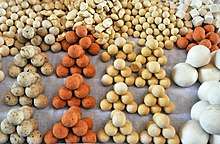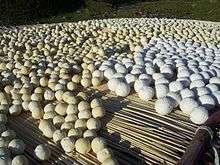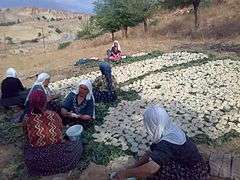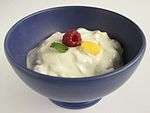Kashk
Kashk (Persian: کشک) is a range of dairy products used in cuisines of Iranian, Turkish, Mongolian, Central Asian, Transcaucasian and the Levantine people. Kashk is made from drained yogurt (in particular, drained qatiq) or drained sour milk by forming it and letting it dry. It can be made in a variety of forms, including rolled into balls, sliced into strips, and formed into chunks.
| Alternative names | Qurut, Qurt, Aarul, chortan, dried yoghurt, jameed, shilanch, kishk, qurut, qqet |
|---|---|
| Type | Gruel, cheese |
| Region or state | Bashkortostan, Caucasus, Central Asia, Kurdistan, Middle East (Levant and Arabian Peninsula), Tatarstan, Tibet |
| Main ingredients | Yoghurt, salt |
| Other information | %21.60- 39.31 water, % 4.5-23.5 fat, %31.22-50.68 protein ve %2.84-13.19 salt[1] |
There are three main kinds of food products with this name: foods based on curdled milk products like yogurt or cheese; foods based on barley broth, bread, or flour; and foods based on cereals combined with curdled milk.
Background

Kashk is a fermented food that is made from grain mixed with sour milk or yogurt, but in modern times is also used for a separate dish of dried buttermilk that can be crumbled and turned into a paste with water.[2] Fermented milk products are affected by numerous factors including the species of milk-producing animal, heat treatment processes for raw milk, fat content of milk, fermentation temperature, and inoculation percentage.[3] Drying allows a longer shelf life for the product.[4] This coarse powder can be used to thicken soups and stews and improve their flavor, or as an ingredient in various meat, rice or vegetable dishes such as the Persian eggplant dish kashk e bademjan.[5][6]
The ancient form of the dish was a porridge of grains fermented with whey and dried in the sun.[7] The long shelf-life and nutritional value of kashk made it a useful item for peasants during the winter months, or soldiers and travelers.[8]
Kashk in different languages and cultures
Kashk is found in the cuisines of Afghanistan, Iran, Iraq, Syria, Egypt, the Caucasus, and Turkey. This expansive geographic area contains different language groups contributing to the complexity of pinpointing the development and usage of this term. In some languages it is called kashk or kishkh, (Persian: کشک, Arabic: كشك, Kurdish: keşk, Turkish: keş peyniri), qurut in others (Kazakh: құрт, Turkmen: gurt, Uzbek: qurt, Azerbaijani: qurut, Kyrgyz: курут, Pashto: قروت, Turkish: kurut, sürk, taş yoğurt, kurutulmuş yoğurt, Shor: қурут). There are many varied names for this class of dishes including jameed (Arabic: جميد), chortan (Armenian: չորթան) and aaruul (Mongolian: ааруул).
According to Francoise Aubaile-Sallenave, the first known literary use of the term comes from the Armenian historian Yeghishe.[9] Chortan is mentioned in the Armenian epic poem Daredevils of Sassoun.[10] First put into written form in the 19th century, the poem is said to be based an 8th century oral tradition.[11]
In the 10th-century Persian Shahnameh ("Book of Kings") by Firdausi the term is used in the sense of "barley flour", but it's also used for a mixture of cracked wheat and cracked barley.[6] Aubaile-Sallenave argues that the original Persian kashk known from early Persian literature was made with barley that contained either a mix of leaven with water or some fermented milk. To answer questions about the modern meaning in Iran for a dried dairy dish she argued "Iranian speaking pastorialists, for whom dried sour milk was a staple, and who had no easy access to barley, applied the word kashk by analogy to dry sour milk". Charles Perry offers an alternate explanation based on the 13th century Arabic cookbook Wasf al-Atimah al-Mutadah which says dried yogurt was a Turkomen style "kashk".[12]
By the Middle Ages the word had two meanings, one referring to barley flour or a mix of barley and cracked wheat, and another to mean a meat or fowl dish cooked overnight (kashak or kashba). A 10th century Arabic cookbook describes two types of kashk, one made of wheat and leaven and another of sour milk.[13] Kashk is the origin of tarhana found in the moderns cuisines of Turkey and Greece, where it is called trachanas (τραχανάς).[8]
Preparation

To make the dried yogurt qurut a traditional or modern method can be used. For the modern method sour yogurt is blended until smooth, then boiled and strained. It is left to ferment in a warm oven for several days, then the moisture is strained and blended with salt to make the kashk. The drained liquid can be used to make qaraqorut ("dried black whey").[14]
For traditionally prepared qurut water is added to full fat yogurt and poured into a goatskin "churn" - a sack hung from a tripod that is swung back and forth until the milk separates into a type of butter and buttermilk. The buttermilk is boiled and drained to obtain curd which is dried in the sun over a period of weeks to make qurut.[14] While traveling in the Baluchistan English explorer Ernest Ayscoghe Floyer encountered this form of kashk:[15]

...from the butter manufacture is left the buttermilk called "dōgh." This is boiled, and the remainder is "luch"; this is pressed and dried, and becomes "shilanch", or in Persian, "kashk," a hard, white biscuit of very sour cheese. This is powdered, and, boiled with savory herbs, is very palatable.
When kashk is made with grain in the Armenian, Arab and Turkish cuisines strained yogurt is added to grain and stored until it begins to ferment. After being left to dry in the sun for over a week it is turned into a coarse powder by rubbing and sifting.[5][6]
Regional cuisines
Caucasus
Matzoon in Armenia and mats'oni in Georgia, is a commonly used ingredient in Caucasian cuisine. One of the ways matzoon is used is for the production of butter. When matsun is churned it separates from the buttermilk. By boiling and churning the buttermilk one obtains ricotta cheese. The product obtained by drying the ricotta clots is called chortan;[16] chor means "dry" and tan means "buttermilk" in the Armenian language.[17]
In Azerbaijan, qurut is made in a similar way from strained yogurt. Yogurt (qatiq) is made from fresh milk and strained to make suzma qatiq. When the buttermilk "whey" has been separated from the butter using traditional methods the buttermilk curds are formed into small balls and dried in the sun.[5]
In western parts of Azerbaijan boiled flat dough is layered with a qurut white sauce and chicken to make Azerbaijani xəngəl.
Central Asia
Qurut dissolved in water is a primary ingredient of qurutob, which is thought of by some as the national dish of Tajikistan.[18] One of the main dishes in Afghanistan is kichree qurut, made with mung beans, rice and qurut dissolved in water. It is sometimes salted, and in Inner Mongolia can be flavoured and distributed as candy.
Iran
In modern Iran, kashk is a thick whitish liquid similar to whey or sour cream, used in traditional Persian and Kurdish cuisine, like ash reshteh, kashk e badamjan, kale joush. It is available as a liquid or in a dried form, which needs to be soaked and softened before it can be used in cooking. Kashk was traditionally produced from the leftovers of cheese-making (more specifically, the milk used to make it). The procedure is, subtracting butter from milk, the remainder is doogh which can be used as the base for kashk. The water is subtracted from this whitish beverage and what remains is kashk which can be dried. Iranian kashk has made an appearance in US markets in the past half-century by several Iranian grocers starting with Kashk Hendessi.
Turkey
In Turkey, kashk is a dried yoghurt product also known as keş peyniri, kurut, taş yoğurt, kuru yoğurt, or katık keşi.[19] Its contents and production vary by region. In western and northern Turkey, especially in Bolu, the product is categorized as a cheese owing to its shape and white color. In eastern Turkey, especially Erzincan, Erzurum, and Kars, kurut is produced from skimmed yoghurt made from the whey left over from production of butter by the yayık method,[20] and then crushed or rolled. In parts of southeastern Turkey with a significant Kurdish population, it is called keşk. All versions of this dairy product are salty. It is used as an ingredient in soups, keşkek, erişte, etc.
There is also a closely related dried food product called tarhana which is based on a fermented mixture of grain and yoghurt or fermented milk. It is very similar to kishk of the Levantine cuisine described below.
Levant and Arabian Peninsula
In Lebanon, Palestine, Arabian Peninsula and Syria, kishk is a powdery cereal of burghul (cracked wheat) fermented with milk and laban (yogurt), usually from goat milk. It is easily stored and is valuable to the winter diet of isolated villagers or country people. Kishk is prepared in early autumn following the preparation of burghul. Milk, laban and burghul are mixed well together and allowed to ferment for nine days. Each morning the mixture is thoroughly kneaded with the hands. When fermentation is complete the kishk is spread on a clean cloth to dry. Finally it is rubbed well between the hands until it is reduced to a powder and then stored in a dry place. In Jordan a dried yogurt similar to kashk called jameed is commonly used. Elsewhere in the Levant, similar products are referred to as drained labneh (labneh malboudeh).
A 10th-century recipe for kishk recorded in the Kitab al-Tabikh was made by par-boiling dehulled wheat, milling it and blending it with chickpea flour. Yeast, salt and water were added to make a dough from the flour, which was left in the sun for around 2 weeks, and re-moistened with sour yogurt (or sour grape juice) as needed. After 15 days the dough would be seasoned with mint, purslane, cilantro, rue, parsley, garlic and the leafy tops of leeks, shaped into disks, and allowed to dry in the sun.[21]
See also
- Frumenty
- Gachas, a Lathyrus gruel consumed since ancient times in parts of the Iberian Peninsula
- Jameed
- Kasha
- Keşkek, a related meat-and-grain stew in Iranian, Turkish and Greek cuisines
- List of yogurt-based dishes and beverages
References
- Z. Tarakçı, M. Dervişoğlu, H. Temiz, O. Aydemir, F. Yazıcı. Review on Kes Cheese. GIDA (2010) 35 (4) 283-288
- "Ferment to be: Yotam Ottolenghi's kashk recipes". The Guardian. July 19, 2013.
- Iranmanesh, Mahdieh. "SPME/GC-MS characterization of volatile compounds of Iranian traditional dried Kashk". International Journal of Food Properties. 21 (1): 1067–1079. doi:10.1080/10942912.2018.1466323.
- "Influence of gum tragacanth on the physiochemical and rheological properties of kashk"". Journal of Dairy Research. 79: 93–101. 2012. doi:10.1017/S0022029911000872.
- Ferment to be: Yotam Ottolenghi's kashk recipes. The Guardian. July 19, 2013.
- Davidson, Alan. The Oxford Companion to Food. Oxford University Press. p. 441.
- "Food facts: A conversation with Gil Marks". Times of Israel. November 4, 2010.
- Lewicka, Paulina (2011). Food and Foodways of Medieval Cairenes: Aspects of Life in an Islamic Metropolis of the Eastern Mediterranean. Brill. p. 230.
- Gueriguian, John L (2005). "Foods and Drinks in Fifteenth Century Anatolia, as Recorded by Amirdovlat Amasiasti". Journal of the Society for Armenian Studies. 14: 155–166.
- "Давид и сборщики дани". Давид Сасунский (in Russian).
- Haroutyunian, S. B. (1990). "Գարեգին Սրվանձտյանցը և հայկական հերոսավեպը (Գ. Սրվանձտյանցի ծննդյան 150-ամյակի առթիվ) [Garegin Srvandztiants and the Armenian Heroic Epic (on the 150th anniversary of his birth)]". Patma-Banasirakan Handes (in Armenian) (1): 3–9.
- Milk-- Beyond the Dairy: Proceedings of the Oxford Symposium on Food and Cookery. 1999. p. 312.
- Cooper, John. Eat and be Satisfied: A Social History of Jewish Food. p. 44.
- Walker, Harlan (1999). Milk-- beyond the dairy : proceedings of the Oxford Symposium on Food and Cookery. p. 70.
- Floyer, Ernest Ayscoghe (1882). Unexplored Baluchistan: A Survery, With Observations Astronomical, Geographical, Botanical, Etc. Of a Route Through Mekran, Bashkurd, Persia, Kurdistan and Turkey. p. 265.
- "Gardens of Biodiversity. Conservation of genetic resources and their use in traditional food production systems by small farmers of the Southern Caucasus". Food and Agriculture Organization of the United Nations.
- "Объяснения некоторых имён и слов". Давид Сасунский (in Russian).
- Jacob, Jeanne; Ashkenazi, Michael (2014-01-15). The World Cookbook: The Greatest Recipes from Around the Globe, 2nd Edition [4 Volumes]: The Greatest Recipes from Around the Globe. ABC-CLIO. p. 1342. ISBN 9781610694698.
- Yurdakök, Murat (2013). "Yoğurdun öyküsü, probiyotiklerin tarihi" (PDF). Çocuk Sağlığı ve Hastalıkları Dergisi. Turkish National Pediatric Society: 46. Archived from the original (PDF) on 16 December 2014. Retrieved 14 December 2014./
- Karabulut I, Hayaloğlu AA, Yıldırım H. 2007. Thinlayer drying characteristics of kurut, a Turkish dried dairy by-product. Int J Food Sci Technol, 42, 1080–1086.
- Nasrallah, Nawal (2007). Annals of the Caliphs' Kitchens. Brill. pp. 209–210.
Bibliography
- Karabulut I., Hayaloğlu A. A., Yıldırım H. Thinlayer drying characteristics of kurut, a Turkish dried dairy by-product. Int J Food Sci Technol, 42 (2007), 1080–1086.
- Françoise Aubaile-Sallenave, Al-Kishk: the past and present of a complex culinary practice, in Sami Zubaida and Richard Tapper, A Taste of Thyme: Culinary Cultures of the Middle East, London and New York, 1994 and 2000, ISBN 1-86064-603-4.
- Liu W J, Sun Z H, Zhang Y B, Zhang C L, Menghebilige, Yang M, Sun T S, Bao Q H, Chen W, Zhang H P. A survey of the bacterial composition of kurut from Tibet using a culture-independent approach. J Dairy Sci. 2012 Mar, 95(3), 1064-72. doi:10.3168/jds.2010-4119.
